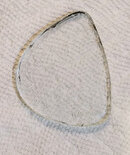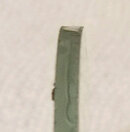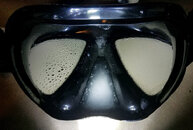I am not sure of the relative densities and miscibility nor happen to have any household ammonia handy to test this, but could vegetable oil be used as a barrier to evaporation? Pour in a thin layer of the ammonia, then carefully, some oil and let it sit ... no exposure of the plastics.
[snip]
I understand that approach, but it seems too messy to become popular. Wikipedia ammonium bicarbonate. My current focus is to add crystals of ammonium bicarbonate to gel toothpaste. This would be done directly on the lens surface. The toothpaste will enhance decomposition of the ammonium salt into low levels of ammonia while keeping the active compound where it is needed. (so the 'theory' goes...)
But wait, ammonia and oil is just so much easier since they are grocery store items, and the last step is the dishwasher so cleanup won't be too bad.
Since I'm going to Giant today, I'll give it a try anyway ...
OK, WTH! They don't have ammonia?!

Sorry (N-S) for the self quotes but I figured that it would better set the stage.
I found out that Randy at Piranha is now carrying the ProMate equivalent of my Tilos mask (best found fit fore my weird face) and ordered one so I had a backup for my BlackBeard's trip. I also figured it was the perfect opportunity to try out my oil-over ammonia concept ...
First I confirmed that the oil was indeed less-dense than the ammonia:
Then I ran both masks through the dishwasher. My 3 year old Tilos (Black) has been scrubbed and through the DW, probably 5 times. The new Grey one just out of the box through the DW once. Then into the fridge for an hour and over a boiling pot of water:
Old:
New:
Next I put the new mask into an old take-out container, inverted the nose pocket and shimmed it with some paper towels to hold it in-place and level. I added enough ammonia to ensure full coverage over the lens and then carefully added the oil:
After waving off the residual from before the oil was added there was no ammonia smell.
6 Days sitting in box. When I removed the cover still no smell. There was a milky layer where there seemed to be some mixing.
Poured off the liquid and rinsed the new Grey mask. Popped both into the DW for another run, fridge for an hour +, then back over some boiling water:
Old:
New (treated):
On the trip, I used the new Grey mask exclusively. Either one drop of Johnson's Baby - or spray of diluted - then rinsed. No fogging whatsoever and I do a good amount of partial mask clearing due to leakage but water was warm (upper 70s).
Tentatively, the ammonia soak seems to work (I'd need to try it in cold-water for a better test).
The oil over ammonia as a barrier also seems to work a treat if you don't want to assemble the ingredients for
@lowviz 's paste recipe.
Looks Like I will be trying it again and ordering another from Randy - The DM on the boat commented that the mask was a long-lost favorite of his and I left it in his care at the end of the trip.








